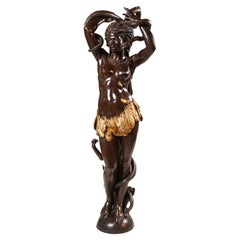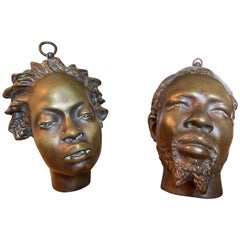African Venus
Maison Marnyhac, "African Venus" , Planter France, Circa 1870
By Maison Marnyhac 1
Located in PARIS, FR
bronze.
A model of a similar African Venus, mounted in floor lamp, has been exposed by Marnyhac during
Category
Antique 19th Century French Napoleon III Planters, Cachepots and Jardini...
Materials
Onyx, Bronze
$497,968
H 51.58 in W 24.81 in D 13.78 in
'African Venus' Bronze Sculpture by C. Marnyhac, France, Circa 1878
By Maison Marnyhac 1
Located in PARIS, FR
An exceptional life-size two patina bronze figure, representing a young African woman taming a
Category
Antique 1870s French Figurative Sculptures
Materials
Bronze
$497,968
H 66.15 in W 21.26 in D 13.78 in
Recent Sales
Charles Cordier, Bronzes "Saïd Abdallah / African Venus", 19th Century
By Charles Henri Joseph Cordier 1
Located in Beaune, FR
Mayac, Kingdom of Darfur and an African Venus.
Artist - Charles Henri Joseph Cordier (1827-1905) French
Category
Antique 19th Century French Figurative Sculptures
Materials
Bronze
An ORIENTALIST ART-DECO Oil on Panel PAINTING by GASTON PRIOU, France 1930
By Gaston Priou
Located in PARIS, FR
, representing an african man and an european Venus, breaking their times sex and race rules together in a
Category
Vintage 1930s French Art Deco Paintings
Materials
Wood
H 44.49 in W 53.55 in D 3.15 in
Jesse Ede, "Venus", Bronze and Slate Stone Coffee Table
By Jesse Ede
Located in Capetown, ZA
. Upon returning to South Africa, he opened a small design and manufacturing studio that provided custom
Category
21st Century and Contemporary South African Coffee and Cocktail Tables
Materials
Slate, Bronze
People Also Browsed
Edo Period Samurai Suit Of Armor
Located in New Orleans, LA
This exquisite Tetsusabiji Uchidashi Gomai Dou Gusoku (Five-Plate Russet Iron Embossed Cuirass Armor), crafted in the 18th century, exemplifies the pinnacle of Edo-period samurai arm...
Category
Antique 18th Century Asian Edo Arms, Armor and Weapons
Materials
Copper, Iron
A Piece of Mars - Martian Meteorite
Located in London, GB
MARTIAN STONE - NWA 14713
Lherzolitic shergottite
127 g
“This 127-gram fragment of the NWA 14713 meteorite displays a green-black mottled exterior. The rock is a martian shergott...
Category
Antique 15th Century and Earlier North African Natural Specimens
Materials
Stone
IMPORTANT MUSEUM QUALITY ANTIQUE 1680 TO 1720 GERMAN SiLVER SAFE STRONGBOX
Located in West Sussex, Pulborough
Royal House Antiques
Royal House Antiques is delighted to offer for sale this important, Museum Quality German safe circa 1680-1720 attributed to Johann Gottlied Dittman and Sigmund...
Category
Antique 1680s Charles II Trunks and Luggage
Materials
Iron, Nickel
$164,376
H 33.86 in W 35.04 in D 20.48 in
Cartier Gold Minute Repeater
By Cartier
Located in New Orleans, LA
This minute repeater carriage clock by the esteemed Cartier is a masterpiece of luxury and craftsmanship created circa 1900. Finished in gold, diamonds and cabochon moonstone with an...
Category
20th Century French Belle Époque Carriage Clocks and Travel Clocks
Materials
Agate, Gold, Enamel
Steinway & Sons Concert Grand Piano
Located in SAINT-OUEN-SUR-SEINE, FR
This extraordinary concert grand piano with 88 keys was made by the prestigious firm Steinway & Sons around 1894. The case's decoration was entrusted to the company Cuel & Cie and mo...
Category
Antique Late 19th Century French Louis XV Musical Instruments
Materials
Wood, Giltwood
German Mother of Pearl Snuff Box
Located in New Orleans, LA
Magnificent layers and inlays of multi-colored mother-of-pearl cover each side of this breathtaking German snuff box. Each incredibly detailed scene is framed by finely engraved yell...
Category
Antique 18th Century German Other Decorative Boxes
Materials
Gold
PLAYBOY BUNNY
By Andy Warhol
Located in Aventura, FL
Synthetic polymer drawing on paper. Unsigned. Warhol Foundation stamp on verso. Sheet size 31.5 x 23.5 inches. Custom framed as pictured.
Artwork is in excellent condition. Cert...
Category
1980s Pop Art Figurative Drawings and Watercolors
Materials
Paper, Polymer
The Bather by Childe Hassam
By Childe Hassam
Located in New Orleans, LA
Childe Hassam
1859-1935 American
The Bather
Signed and dated “Childe Hassam” (lower right)
Oil on canvas
Considered by many to be America’s foremost Impressionist painter, Childe...
Category
20th Century Impressionist Nude Paintings
Materials
Canvas, Oil
19th C. Royal Casket Box/Safe with Coat of Arms, Gold, Damascene, Etched Steel
Located in New York, NY
An Incredible 19th Century Royal Casket Box/Safe with Coat of Arms, Made of Gold, Damascene, and Etched Steel. Charles Le Hon, a Belgian politician, lawyer and industrialist, served...
Category
Antique 1850s French Renaissance Revival Decorative Boxes
Materials
Gold, Steel
$260,000
H 6.75 in W 17.5 in D 12.25 in
Solo Lui Black Armoire with 54 Watch Winders
By Agresti
Located in New York, NY
Armored armoire in polished Ebony, brass accessories in Ruthenium. Safe with biometric opening device, drawers and trays lined for watches and jewelry. Available with 54 Swiss made w...
Category
21st Century and Contemporary Italian Modern Wardrobes and Armoires
Materials
Ebony
Late Bronze Age Sword
Located in London, GB
Saint Nazaire Sword, Late Bronze Age, circa 800-900 B.C.
An exceptionally well preserved Bronze Age sword, with elegant, finely incised decorations, near perfect form and a wonder...
Category
Antique 15th Century and Earlier French Abstract Sculptures
Materials
Bronze
19th-century Carved, Painted and Gilt tortoise shell, 'the Cosmic Turtle'
Located in Amsterdam, NL
A highly unusual carved painted, gilt and gem-set tortoise carapace resembling the mythical Cosmic or World-bearing Turtle
Probably Germany, late 19th century
L. 32 x W. 26 x H. 20...
Category
Antique Late 19th Century Natural Specimens
Materials
Multi-gemstone, Gold Leaf
$56,910
H 7.88 in W 10.24 in D 12.6 in
Hellenistic Grotesque Theatre Mask of Maccus
Located in London, GB
Grotesque theatrical mask of Maccus
Late Hellenistic or Early Imperial period, circa 1st century B.C. – 1st century A.D., likely from Southern Italy.
Terracotta with remains of pin...
Category
Antique 15th Century and Earlier Italian Classical Roman Figurative Scul...
Materials
Terracotta
Hand-colored 16th century copy of the famous Moerentorf Bible
By Henry Moret
Located in ZWIJNDRECHT, NL
Publisher: Daniel Vervliet and Hendrik Swingen for Jan I Moretus & Jan I van Keerberghen
Place / Date: Antwerp, 1599
Biblia sacra. Dat is de geheele heylighe schrifture bed...
Category
Antique 16th Century Belgian Baroque Books
Materials
Wood, Paper
$28,899 Sale Price
25% Off
H 13 in W 10.63 in D 4.34 in
TOLKIEN, J. R. R. - The Hobbit - 1937 - FIRST EDITION - FIRST PRINTING !
Located in Hillsborough, NJ
AUTHOR: TOLKIEN, J. R. R.
TITLE: The Hobbit or There and Back Again.
PUBLISHER: London: George Allen & Unwin Ltd, 1937.
DESCRIPTION: FIRST EDITION FIRST PRINTING. 1 vol., 7-11/16...
Category
Vintage 1930s British Books
Materials
Fabric
$57,500
H 7.69 in W 5.63 in D 1 in
Ancient South Arabian Alabaster Statue
Located in London, GB
South Arabian Calcite female figure
3rd Century BC to 1st century A.D.
Calcite Alabaster
height: 30.5 cm
A magnificent alabaster female figure, a fine example of the well-studi...
Category
Antique 15th Century and Earlier Yemeni Figurative Sculptures
Materials
Alabaster
Get Updated with New Arrivals
Save "African Venus", and we’ll notify you when there are new listings in this category.
African Venus For Sale on 1stDibs
There is a range of African venus for sale on 1stDibs. Frequently made of metal, organic material and resin, all African venus available were constructed with great care. We have 5 antique and vintage African venus in-stock, while there are 9 modern editions to choose from as well. There are all kinds of African venus available, from those produced as long ago as the 19th Century to those made as recently as the 21st Century. Art Deco and louis xv African venus are consistently popular styles. African venus have been a part of the life’s work for many furniture makers, but those produced by Barron Claiborne, Barbara Barron and (After) Henry Taylor are consistently popular.
How Much are African Venus?
The average selling price for at 1stDibs is $7,500, while they’re typically $450 on the low end and $260,076 highest priced.
More Ways To Browse
Cupid And Psyche Statue
Vintage Mcdonalds
Kneeling Venus
Lalique Sirenes
Vintage Copper Bed Frame
Martin Baker
Thorvaldsen Bust
Werkstatte Beaded
Canova Psyche
Mexican Ceramic Dove
Antique Giant Clam Shell
Angelika Kauffmann
Ceramic Evil Eye
Danish Banana Chair
Hans Wegner Venus
Jean Charles Onyx
Moorish Fountain
Vintage Holy Water Font


